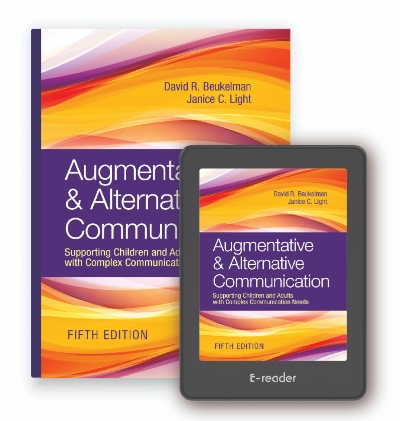Today’s most comprehensive, up-to-date introduction to AAC interventions and technologies
Augmentative & Alternative Communication
Supporting Children and Adults with Complex Communication Needs, Fifth Edition

Edited by David R. Beukelman, Ph.D , & Janice C. Light, Ph.D. with invited contributors
This classic bestseller is now in its fifth edition—revised and updated for a new generation of SLPs, teachers, occupational therapists, and other professionals in clinical and educational settings. Partnering with a team of distinguished contributors, renowned experts David Beukelman and Janice Light deliver today’s most comprehensive, up-to-date introduction to AAC interventions and technologies for children and adults with complex communication needs.
What’s new in the fifth edition
Professionals will prepare for their work in the field with critical new information on:
- Collaborating with family members and other communication partners
- Making the most of mobile technologies and AAC apps
- Selecting an AAC system and tailoring it to individual needs
- Working effectively with families from diverse cultural backgrounds
- Supporting inclusion across the lifespan (including education, employment, and community life)
- Ensuring efficient patient-provider communication in medical settings
- Providing communication supports to people with autism spectrum disorder
Want to learn more about this edition? See the full listing.
Supplement your teaching with these Online Companion Materials
- Sample syllabus
- Resource guide to help practitioners and students learn more about AAC
- Sample responses to study questions
Meet the volume editors

David R. Beukelman, Ph.D.
Dr. Beukelman is currently a senior researcher in the Institute for Rehabilitation Science and Engineering at Madonna Rehabilitation Hospital and a research investigator in the Rehabilitation Engineering Research Center for Augmentative and Alternative Communication. Dr. Beukelman specializes in the areas of augmentative and alternative communication and motor speech disorders of children and adults.
Full bio »
Janice C. Light, Ph.D.
Dr. Light holds the Hintz Family Endowed Chair in Children’s Communicative Competence in the Department of Communication Sciences and Disorders at Pennsylvania State University. She is actively involved in research, personnel preparation, service delivery, and outreach to enhance communication and improve outcomes for children with complex communication needs (e.g., children with autism spectrum disorder, cerebral palsy, Down syndrome, traumatic brain injury, and other disabilities).
Full bio »
Invited Contributors: Laura J. Ball, Ph.D., Susan Koch Fager, Ph.D., Kathryn L. Garrett, Ph.D., CCC-SLP, Elizabeth K. Hanson, Ph.D., CCC-SLP, Julia King Fischer, Ph.D., Joanne P. Lasker, Ph.D., CCC-SLP, David B. McNaughton, Ph.D., Amy S. Nordness, Ph.D., CCC-SLP
View the table of contents
About the Authors
About the Contributors
Preface
About the Online Companion Materials
Acknowledgments
Section I People Who Require Augmentative and Alternative Communication
Chapter 1 Augmentative and Alternative Communication Processes for Children and Adults with Complex Communication Needs
Chapter 2 AAC Assessment
Chapter 3 Overview of AAC Intervention
Chapter 4 Collaborating with Family Members and Other Communication Partners
Section II Augmentative and Alternative Communication Systems
Chapter 5 Vocabulary Selection and Message Management
Chapter 6 Representation, Organization, and Layout of AAC Systems
Chapter 7 Access Techniques and Output
Chapter 8 Selection and Personalization of AAC Systems
Section III Augmentative and Alternative Communication Interventions for Individuals with Developmental Disabilities
Chapter 9 Key Considerations in Augmentative and Alternative Communication Intervention for People With Developmental Disabilities
Chapter 10 Intervention to Support Communication and Participation of Beginning Communicators
Chapter 11 Intervention to Build Communicative Competence
Chapter 12 Literacy Intervention for Individuals with Complex Communication Needs
Chapter 13 Intervention to Enhance Participation in Education, Employment, and Community Settings
Section IV Augmentative and Alternative Communication Interventions for Individuals with Acquired Disabilities
Chapter 14 Individuals with Acquired Physical Conditions
Chapter 15 AAC Supports for Adults with Severe Aphasia and/or Apraxia of Speech
Chapter 16 Adults with Degenerative Cognitive and Linguistic Conditions
Chapter 17 Individuals with Traumatic Brain Injury
Chapter 18 Patient-Provider Communication in Medical Settings
Chapter 19 The Importance of Advocacy
Index
More resources
- A handy chart that shows you what’s been added and updated in the new edition
- A book excerpt that includes the full table of contents
- A sample course outline that shows how to use this new edition in the classroom
- A written Q&A with the authors about the benefits of and updates to the new edition
- A slide deck with a comprehensive overview of the new edition

